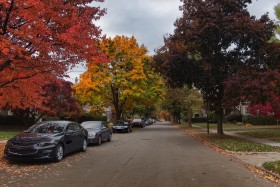Road Safety Tips: Driving Safely in Residential Areas

No matter what your personal driving habits are like, there’s a good chance that you spend a good amount of time driving in residential neighborhoods. Even though many people drive in residential areas on a daily basis, it’s very important to not become complacent.
When people frequently drive the same routes, they often zone out and stop paying attention to what’s going on around them. Residential neighborhoods may have low speed limits, but they’re full of hazards that can potentially lead to serious accidents. Here are some important things you can do to make sure you and others in your neighborhood stay safe.
Always Scan Your Surroundings
Residential neighborhoods can be very full of activity. You may often see children playing in yards, people walking their pets, people riding bikes, and joggers getting their exercise in. But sometimes, people can behave in unpredictable ways. For example, a young child might run into the street to chase a ball. Or in some cases, something might obstruct your view of a pedestrian or bicyclist. These situations are prime examples of why it’s so important for drivers to constantly be watching their surroundings. A driver being distracted, even for just a few seconds, can easily end in tragedy.
Obey the Speed Limit
Speeding is a very common problem in residential areas. Sometimes, people go 5-10 miles over the speed limit thinking that it won’t make a big difference, that nobody will get hurt by their actions, or that they won’t get caught. But residential areas have low speed limits for very good reasons. With so many people out and about and cars backing out of driveways, low speeds are needed to help protect the safety of everyone in the neighborhood. The faster a car is traveling, the stronger the force will be if it crashes. So if a driver hits another car or a pedestrian at a low rate of speed, the less likely it is that serious injuries or death will occur.
Watch for Traffic Signs
This might seem like an obvious point to make, but since so many people tend to think of residential streets as being safe areas to drive in, people can sometimes get a little lax about obeying traffic signs. For example, you might see drivers making rolling stops at intersections instead of coming to a complete stop, but even if there doesn’t seem to be a lot of other traffic around, traffic signs still need to be followed.
On many residential streets, you might not see any traffic signs beyond a standard stop sign. But in other areas, you might see signs alerting drivers to other important things like hidden driveways, school bus stops, and school zones.
Eliminate Distractions
Whether you’re driving on the interstate or in a residential neighborhood, one of the best things you can do to prevent a car accident is eliminate distractions before you even start driving. If you’ll be using a GPS system to get directions, make sure it’s programmed before you head out. Make sure your phone is on silent or kept in an area where you won’t be tempted to check it while driving. If you’re driving with a pet in the car, make sure they’re contained and won’t cause you to take your eyes off the road or your hands off the wheel while driving.
If you’ve been seriously injured in a car accident, one of the best things you can do is get in touch with a car accident lawyer. Insurance companies might try to pressure you settle for less than you deserve, but a lawyer can help make sure you get all of the compensation you deserve. At Goodwin & Scieszka, we have lawyers who are experienced in helping the victims of Michigan car accidents. Contact us today for help with your case.
Image: iStock / DebraMillet






